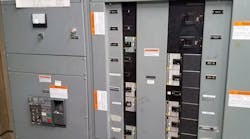Managers and business owners who have employees performing electrical work in their facilities most likely have considered having an arc flash analysis performed on their equipment. Typically, a few calls have been made to some engineering consulting firms to solicit proposals on what it will take to get arc flash stickers posted on the electrical equipment. After digesting the “sticker shock” associated with what a significant arc flash analysis costs, managers often move on to the next issue they are faced with and put the whole “arc flash analysis” issue on the back burner. After all, you can still use the arc flash PPE selection tables in the NFPA 70E standard, right? Sounds like a money saver…
Should electrical professionals keep relying on the NFPA 70E Tables?
I would argue the answer to this question is a resounding no, and here’s why. The reality is you still have not solved the problem. Keep in mind that the problem that needs to be solved is determining the precise hazard employees are faced with and what it takes to properly protect them from that hazard. In more personal terms, the problem is ensuring employees are not burned from exposure to an arc flash event. Sure, the standards allow you to use the tables, but keep in mind they aren’t an exact science. And let’s face it: Most employees probably aren’t using them properly, but that’s a discussion for another article. Employers must be sure their employees are protected from the specific arc flash hazard levels at every location of the facility’s electrical system.
How can employers ensure employees are protected from arc flash hazards?
The only way to know exactly what personal protective equipment (PPE) is needed to protect employees from arc flash hazards is to perform an incident energy analysis. Simply put, when industrial or commercial electrical distribution equipment fails, it can potentially result in an explosion. This “explosion” is the manifestation of incident energy. Basically, electrical distribution equipment and the equipment configuration need to be evaluated to determine how much incident energy (heat generated from the explosion) can be produced during a worst-case failure. Incident energy is measured in calories per centimeter squared (cal/cm2). A calorie is the amount of energy it takes to raise the temperature of one gram of water one degree Celsius. An arc flash analysis determines the most severe incident energy that can be produced at each location of the distribution system so that there’s no doubt what level of arc flash PPE is required to protect workers from receiving burns during an arc flash event.
How is this analysis performed?
The first step of an arc flash analysis is data collection. A properly performed analysis requires information about every conductor, disconnecting device, protective device, transformer, capacitor, motor, and any other piece of electrical equipment associated with the electrical distribution system. Information is also needed from the electrical service provider. After the necessary data is collected, the entire electrical distribution system will be modeled either by hand or in a software program that will then be used to calculate the incident energy at any location where maintenance or operations activities could be performed.
Keep in mind the accuracy and completeness of the information collected and used to model a system will have a direct correlation to the accuracy of the incident energy calculations that will be used to determine the required level of arc flash PPE. A common mistake companies make is rushing the data collection process and making assumptions just to get stickers on their equipment faster. The problem with this is that the quality of the end product has been negatively impacted because of a desire for a quicker schedule. An accurate and effective arc flash analysis takes time and money, but it could save someone’s life.
Now that the analysis is complete and stickers are on, the process is finished, right?
Not quite. The NFPA 70E requires that the arc flash analysis be reviewed at a frequency not to exceed five years. It also requires it to be updated when any changes are made to the system. There is a key principle to understand related to arc flash energy: Arc flash energy is determined by the available fault current at the location of the fault and the amount of time it takes to clear the fault. Let’s assume there’s a fault inside a motor control center, and a breaker immediately upstream clears the fault. The arc flash analysis makes the assumption that the breaker will open in accordance with the protective setting design, and the contacts will separate at a speed for which it is designed. A poorly maintained breaker will eventually begin to respond slower than designed — and, in extreme scenarios, it may not respond at all. In this case, the arc flash energy levels can greatly exceed the level calculated by the analysis. Therefore, an Effective Electrical Equipment Maintenance Program (E3MP) is an essential part of maintaining an accurate arc flash analysis program.
Additional benefits
There are often overlooked side benefits of having the arc flash analysis performed as well. After the analysis is complete, a thorough database of all of the electrical equipment now exists, their configuration, and their protective settings. Often, the analysis leads to updating existing drawings so that a complete set of accurate one-line diagrams is available of the entire distribution system. Depending on the company hired to perform the analysis, there could also be the benefit of a knowledgeable person taking an “outsider” look at the system who may be able to see things that could be changed to help improve efficiency or avoid some developing electrical failure. Many people identify equipment coordination issues that can lead to larger outages than necessary when a breaker trips. These are just a few of the examples that hopefully start to paint the picture that the benefits greatly outweigh the up-front capital investment.
While it may seem like ensuring that electrical workers are protected from arc flash hazards is a cost that has no end, many available studies verify the return on investment for electrical safety is a profitable endeavor. Here’s the bottom line: There’s no price you can put on avoiding a phone call to inform an emergency contact their loved one has been severely burned in an arc flash event. Make the smart choice and get an arc flash analysis study started today.
Northcott, a professional engineer licensed in the state of Tennessee and a certified maintenance and reliability professional, is a senior power engineer with Jacobs Technology, Inc., in Tullahoma, Tenn. He can be reached at [email protected].





